Four decades and counting… The birth of the mobility scooter revolution
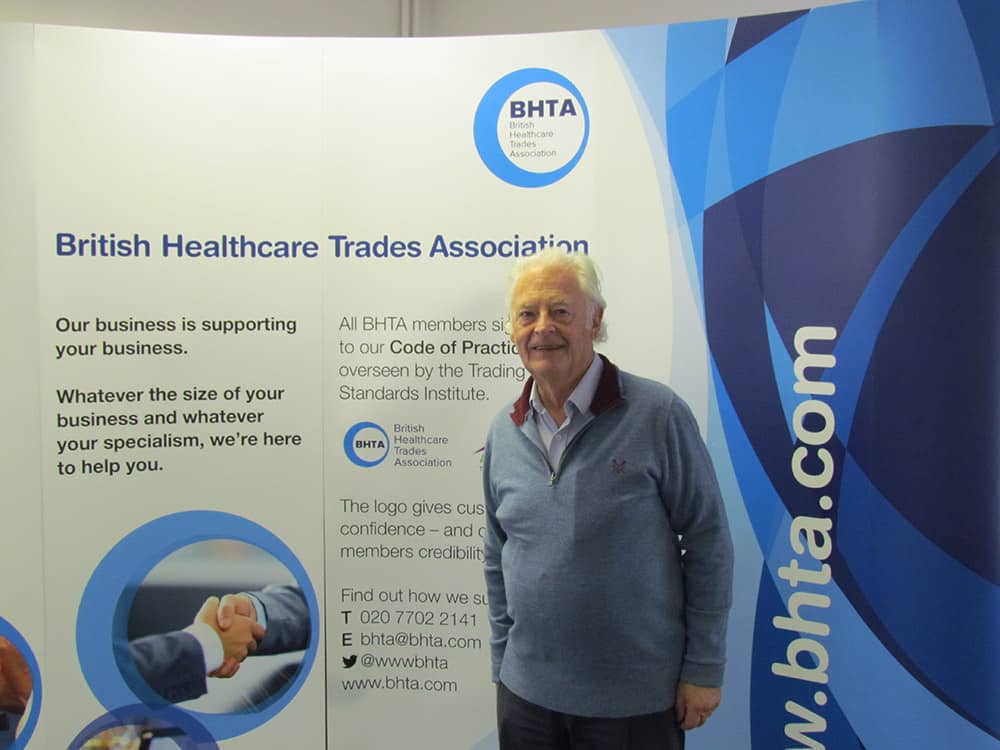
When Ray Hodgkinson MBE and Martin Corby set up Raymar in 1978, the pair did not imagine they were taking the first steps in what would be a revolution in the world of mobility. Starting with a shoestring budget and a goal of introducing new mobility and rehabilitation innovations, the company ended up being the first to bring the modern mobility scooter to the shores of the UK. 41 years on, Ray reflects on the early days distributing the new technology and discusses what the future holds for the popular mobility scooter in the future.
In 2014, a market overview of mobility scooters by the Research Institute for Consumer Affairs (Rica) reported that an estimated 80,000 mobility scooters are sold every year and around 300,000 to 350,000 of the mobility devices were on roads and pavements up and down the UK.
Now, some suggest that number could have risen to as high as half a million over the past five years, however, just over four decades ago in 1978, a mobility scooter had never been seen on a British street.
Motivation to find innovation
It was at this time that Raymar was established by Ray Hodgkinson and Martin Corby, a company aiming to bring innovative, new products to the fast-growing UK assistive technologies market.
Discussing Raymar’s early day, Ray told THIIS: “I had been fortunate to travel the world marketing the first ultra-lightweight wheelchair ‘The Newton’, an all-aluminium self-propelling wheelchair which was later adapted to electric power.
“Interestingly, healthcare professionals and clinicians were quite dismissive at the time and doubted its clinical application, only suiting the most agile of disabilities. It is a thought that still exists today!” Ray Hodgkinson
“I had come across an innovative solution to manage pressure ulcers ‘The ROHO Cushion’ and an interesting range domestic stairlifts and wheelchair lifts from the USA.”
Keen to bring these new finds to the UK, the pair started the company on what Ray describes as a shoestring budget and quickly found that people were both intrigued and excited about the new developments and inventions the company were introducing.
A lucky introduction
It was during the early days of Raymar that Ray first came across a mobility scooter.
Recounting how the Amigo was first brought to his attention, Ray explained: “Out of the blue, a very forward-thinking and much respected occupational therapist Alison Wisbech who was working with disabled children at the Wolfson Centre in London informed us about a new type of mobility product from the USA.
“It had been brought over by a friend of hers, a doctor practising in West London. He, nor Alison, had any interest in taking it further but encouraged us to assess it.”
The device in question was the Amigo Scooter, a three-wheeled device with a platform, electric motor to drive the front wheel featuring a tiller style steering system and a seat that swung around to make access easier.
Designed by American inventor Al Thieme, a plumbing and heating contractor in Michigan, USA, he worked away in his garage in the late 60s creating a new personal mobility device that could help meet the needs of a loved one.
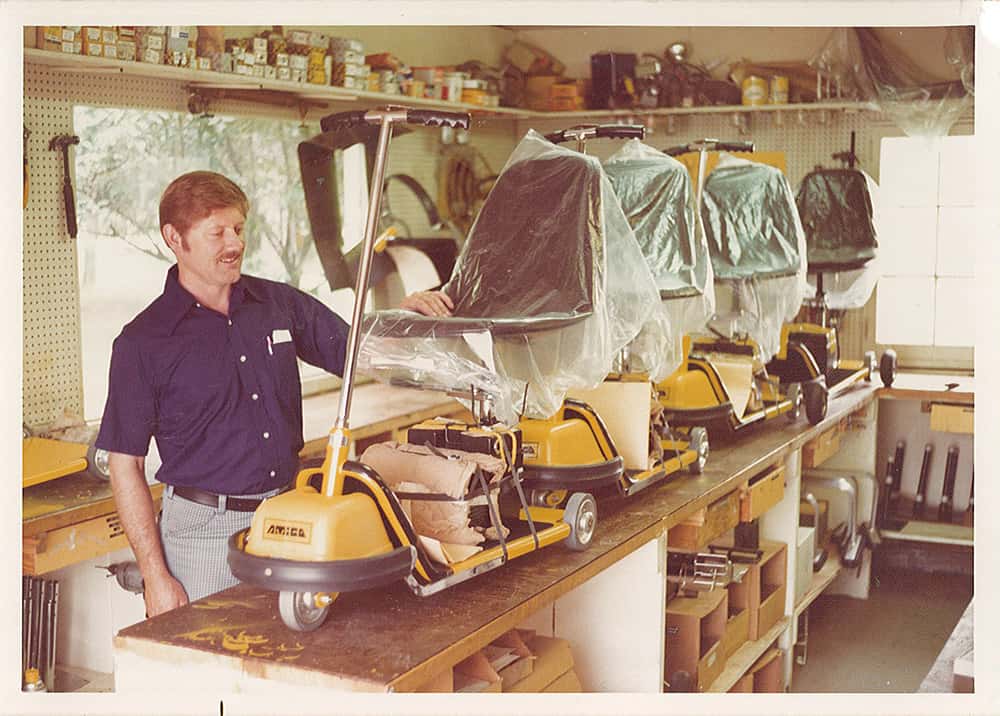
Intrigued, Ray and Martin set off to America to find out more about Al and his new product.
Recollecting on the meeting, Ray told THIIS: “A more enthusiastic and dynamic American you could not meet!
“Al Thieme had been inspired to try and help his wife who was suffering from multiple sclerosis. Her ability was becoming limited and one day after seeing a hoover being used, he had one of those eureka moments. Could he use the motor of the hoover to drive a wheel that could, in turn, be enough to move a person seated on a chair? Could it be used indoors and outdoors and around the local environment, thus bringing a degree of independence to his wife? At that time in the USA, powered mobility devices were very large clumsy and often impractical in the home environment, as well as seen as costly.”
Ray’s reservations
With hundreds of thousands in use and tens of thousands sold annually, the decision to introduce the product to the UK may seem like a no-brainer with the benefit of hindsight, however, at the time, Ray had his reservations regarding its chances in the market.
“It would be wrong to say we rushed into the market,” he emphasised.
“Having experienced the UK wheelchair provision dominated by the Department of Health and the general attitude towards the limited choice of mobility products for disabled people, I was not convinced that the prevailing circumstance that existed then would accept such a radical change to mobility.”
Despite his concerns, the former BHTA Director General notes that he knew the product was revolutionary to many of the undesirable solutions that were available for disabled people at the time.
“Why the Government is in a seemingly churlish position by restricting the funding of the mobility scooter is unclear.” Ray Hodgkinson
“It would not be exaggerating to say that using a wheelchair, non-powered and power, had a stigma and was the last resort for many. The wheelchairs were very standardised, heavy and unattractive. There had been little innovation since the advent of Everest and Jennings introducing new designs of wheelchairs and most products were copies of each other,” recalled Ray.
Taking the leap
In spite of his trepidations, Raymar took a chance on the device, with the Amigo sold by Raymar going on to be the very first mobility scooter sold in the UK, a claim Ray says he is happy to stand by.
Described as the first significant change in the powered wheelchair market in many years, the Amigo quickly made headway in the UK and went on to become one of Raymar’s best-selling products.
“To see the Amigo was in those days quite remarkable as it challenged all the thinking on mobility,” reflected Ray.
“Raymar caused a stir for two or three years or so as we were the only people pioneering this new form of mobility aid. All sorts of people, adults and children, with a wide range of mobility limitations which included those with multiple sclerosis, motor neurone disease, muscular sclerosis, arthritis and spinal injuries began to buy the Amigo.”
According to Ray, the device’s popularity amongst users was because it did not suffer from the stigmas associated with wheelchairs, which he describes as the symbol of disability.
“They saw mobility in a different context,” continued Ray.
“It could be fun and it brought about interest and helped to integrate disability.”
The market expands
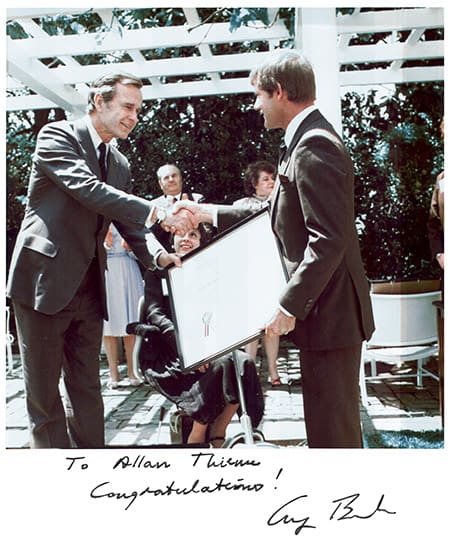
The company decided to market the product on the freedoms it gave users over alternative mobility solutions on the market, which lacked the scooter’s agility.
“A revolution had begun, although I did not appreciate it at the time,” said Ray.
“We were competing with power wheelchairs and we marketed this as being the opposite to the big, cumbersome devices that were on the market, instead highlighting the additional freedom that the Amigo offered, such as being easier to get into the car and easier to move around the house in.
“Really pushing the ‘freedom’ element of the Amigo is what really led to its popularity.”
Having seen the growing demand for the new personal mobility device, however, more players entered the market, keen to get involved in the emerging market by launching and selling their own mobility scooters.
“We created so much interest that it was not long before competitors entered the market,” remembers Ray.
“One of the early copies came from Ray Biddle at BEC (Biddle Engineering). He did a good job and had much support from David Hull who many old enough will remember was head of development at Sunrise Medical for many years. Sadly, he passed away prematurely. Ray Biddle sold his business to Sunrise and was able to retire and enjoy his motorcycling to which he was devoted and had a reputation of being somewhat wild alongside David Hull!”
Enjoying success bringing in the Amigo, Raymar also introduced their own mobility scooter into the market during the market’s early years.
“It was called the Solo and it sold to some extent but it did not take long for the market to become pretty fierce, with bigger players such as Invacare and Sunrise entering the market,” said Ray.
“I did not have the investment ability at the time to take our range to where it needed to go.
“I would say Amigo in America was a little short-sighted in not seeing the price competition in Europe, so we found ourselves struggling to remain competitive as larger players entered with their offering.
Since those formative years, the mobility scooter market has continued to grow significantly from the days of the three-wheeled Amigo, with today’s mobility scooters now providing advanced features that would not look out of place modern cars, from run-flat tyres to incorporating smart technology.
Lack of clinical credibility
Despite the increased development of the products, however, Ray believes there are still some underlying issues inherent to the market that have prolonged over the years, particularly in regards to mobility scooters clinical credentials.
“Interestingly, healthcare professionals and clinicians were quite dismissive at the time and doubted its clinical application, only suiting the most agile of disabilities. It is a thought that still exists today!” he claimed.
“We came up against those criticisms a lot and so convincing clinicians about the products’ positive credentials was a struggle.”
“There should be qualifications required for selling these products” Ray Hodgkinson
It was these clinical criticisms that the former Raymar director says has played a role in restricting the amount of Government support for the device over the years.
“Clinically, I do see the caution but scooter development has made great strides forward and they are governed by the same regulations i.e. transport, CE marking under the MDD and International Standards as wheelchairs; they are essentially the same but just look different,” emphasised Ray.
“Why the Government is in a seemingly churlish position by restricting the funding of the mobility scooter is unclear. Funding should be available for users to choose what is best for them to meet their requirements. Perhaps the move towards Personal Wheelchair Budgets provides an opportunity to rectify this ambiguity and kill off the myth that the new generation of mobility products, such as scooters, are not performing the same function.”
Making the case for funding the provision of mobility scooters, Ray asserts those with mobility needs should be able to choose which device best meets their requirements under clinical guidance, with scooter being a legitimate clinical option contributing to social, physical and mental health needs.
“If you go to Wheelchair Services, you can get a powered mobility product but it will not be a mobility scooter, which I still think is wrong. By widening the net of choice, this will stimulate even more development, better products and cost-effectiveness,” he maintained.
“Where cost effectiveness is concerned, it is not just the product and service costs that should be examined, but rather include the savings brought throughout the system where people are able to do things for themselves, work, play and go to school and university.”
The public has spoken
Considering the hundreds of thousands of mobility scooters in circulation, Ray contests the mobility scooter’s enduring popularity amongst users is evidence that, despite the lack of Government or clinical backing, there is a clear consensus amongst the public for the need of mobility scooters in the world of disability.
“Undeniably, the public themselves have driven the growth and somewhat flown in the face of government policy, in particular, the Department of Health and Wheelchair Services, as well as clinicians, confirming mobility scooter validity and widespread acceptance,” added Ray.
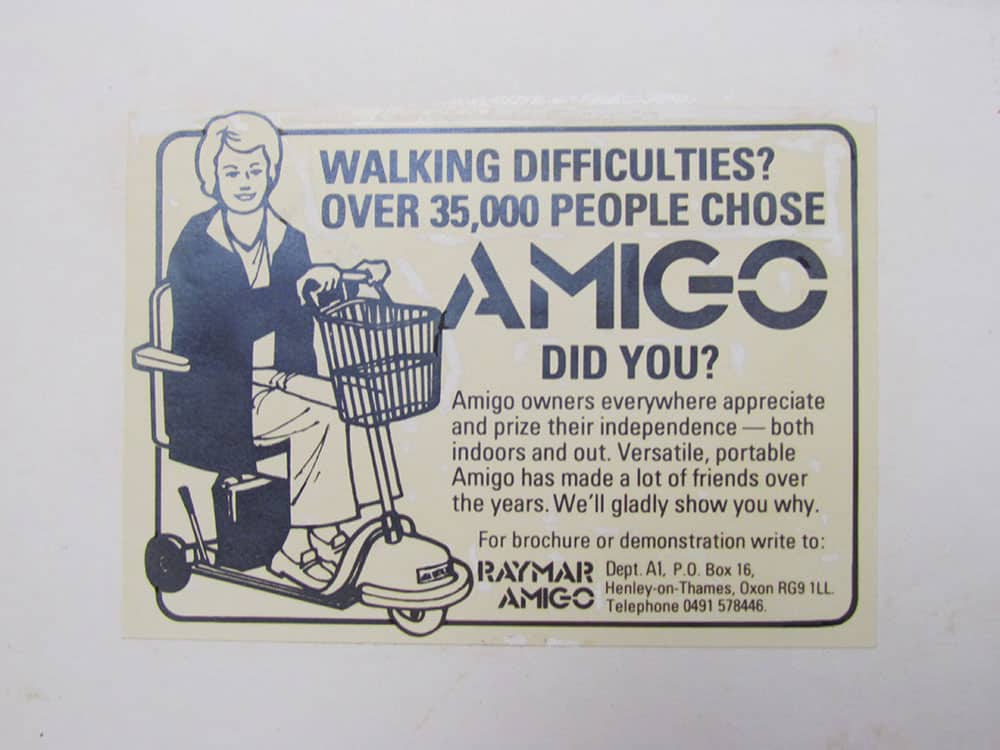
Growing concerns
With market research specialists Global Info Research predicting the global travel mobility scooter market will continue to expand in the years to come, potentially reaching over one billion dollars ($1.07billion) by 2023, the popularity of the devices does not seem to be dissipating.
As the products’ popularity has grown over the decades, with more mobility scooters in circulation than ever before, so too has the number of accidents and, worryingly, fatalities, resulting in increased media and public scrutiny.
Highlighting some of the key issues surrounding mobility scooters, Ray commented: “The danger with mobility scooters is that there isn’t proper training, the control of them into the marketplace needs to be tighter, retailers need to have greater knowledge on people’s conditions, and users themselves need to be acutely aware that they are sitting on something that can be lethal if not driven properly.”
The industry needs to step up
Rather than waiting for the Government to step in with regulations to tackle the issues, Ray states the industry needs to be on the front foot to address the growing concerns. One element he contests is vital is the need to introduce qualifications.
“There should be qualifications required for selling these products. Drawing a comparison to the spectacles market, when people go in for glasses, someone qualified will assess that individual and give them a prescription. I think the same needs to be introduced for mobility scooters and really all assistive technology,” noted Ray.
“If you have someone who is qualified and has prescribed a particular type of mobility vehicle following an assessment, then the consumer should be free to go anywhere they want to buy the product, be it in-store or on the internet.”
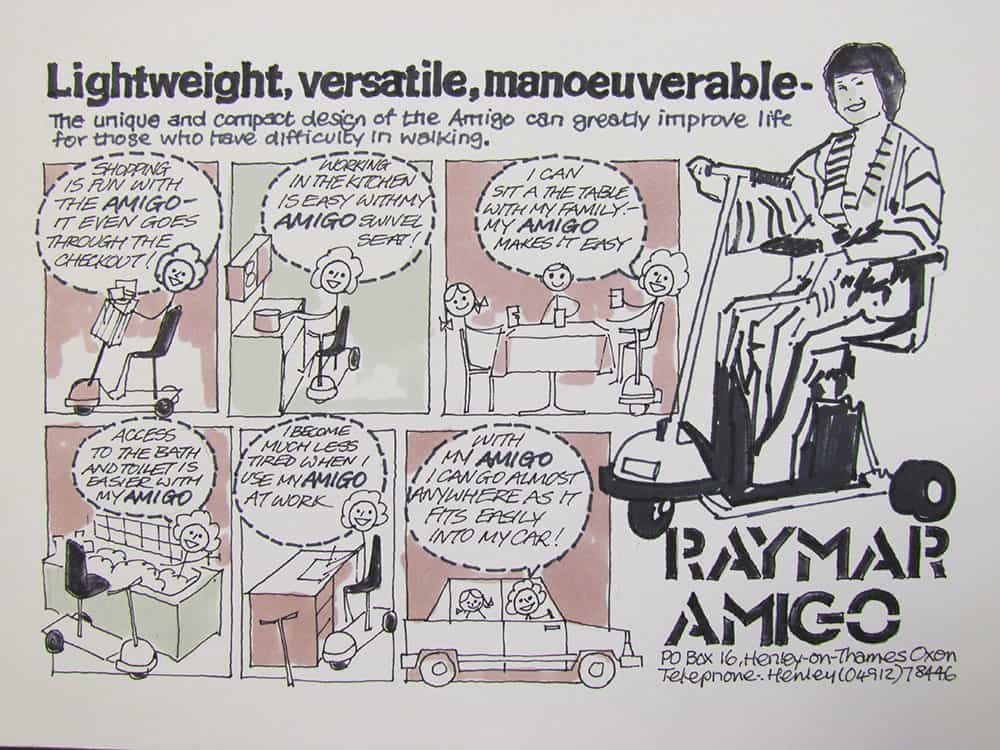
Introducing qualifications for sellers will help deliver more professionalism argues Ray, asserting that whilst the industry has grown tremendously over the past 40 years, there is still a need for further development.
“I am not being critical of the industry as it has grown incredibly over the decades, particularly with the introduction of the BHTA’s Code of Practice, and delivered incredible freedom and independence to so many people. But there is still more work to be done. Look at what chains like Specsavers have done in the spectacle market for example – modern, smart conditions with trusted, qualified individuals. I think our industry has a fantastic opportunity to move more in that direction and that’s not just on the mobility scooter front, but across all assistive technology,” finished Ray.
“Eventually, there may well come a point where you will not be able to sell in this industry without being qualified and the industry should really look to do this itself.”
Reflecting on a revolution
Looking back over the past four decades, Ray points out just how much of a change the mobility scooter has brought to many disabled people’s lives, referring to the introduction of the mobility scooter as a revolution in the world of mobility aids.
“The wheelchair was a revolution a number of centuries ago and the mobility scooter has brought about another revolution. A single stroke of ingenuity by Al Thieme broke open a new era”, ended Ray.
“I was fortunate enough to be around at the time, take a risk and contribute to its introduction and development so, over 40 years on, we have much to celebrate and be thankful for.
“Mobility is a fundamental right and we can no longer isolate those people requiring sophisticated means to get about their daily business. The mobility scooter has helped develop that freedom and this massive acceptance is an indication of people willing to help themselves despite the hurdles and barriers in front of them.”
Where is Amigo now?
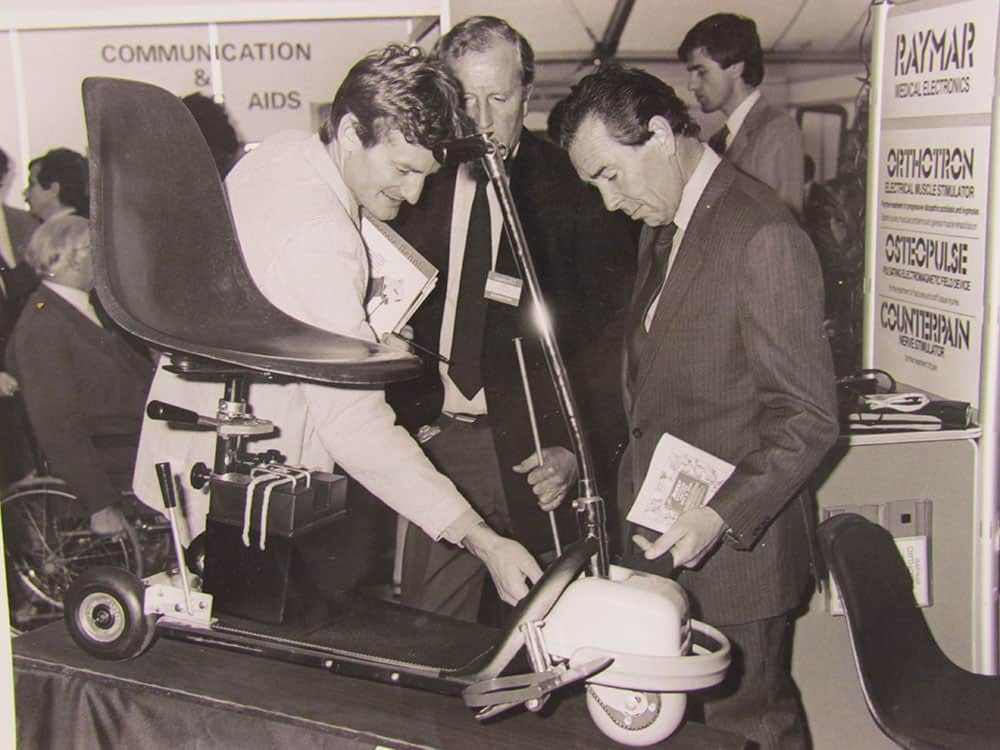
Not currently distributed in the UK, the pioneering mobility scooter supplier is still manufacturing its range of Amigo healthcare models, motorised shopping trollies for supermarkets and a new line of material handling carts at its headquarters in Michigan, USA.
Having just celebrated its 50th anniversary last year, Al Thieme still runs the company with his wife Beth Thieme and the second generation is also working in the business to see it grow into the next 50 years.


